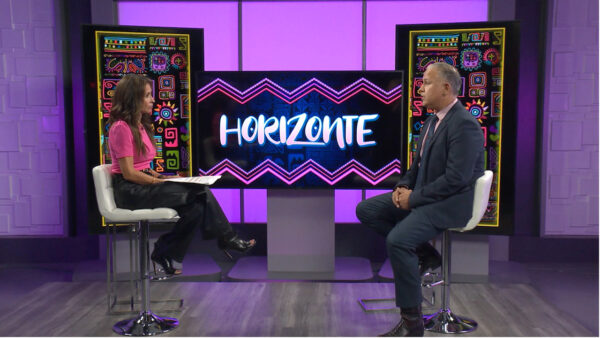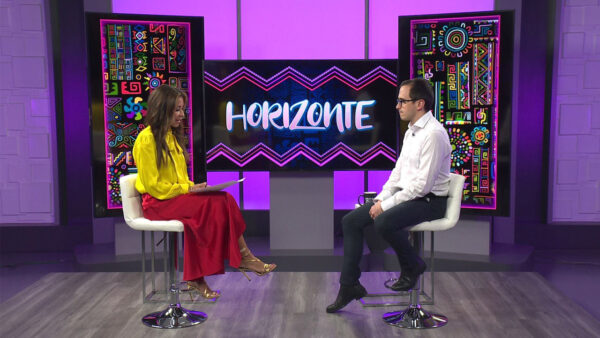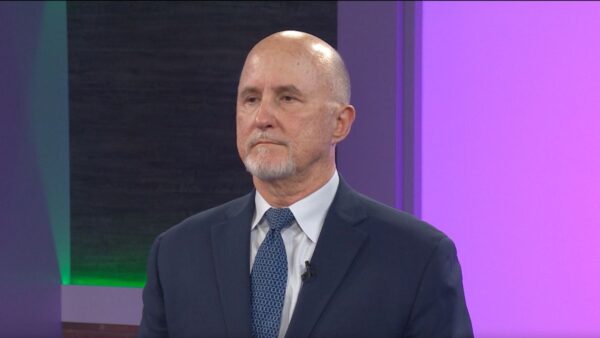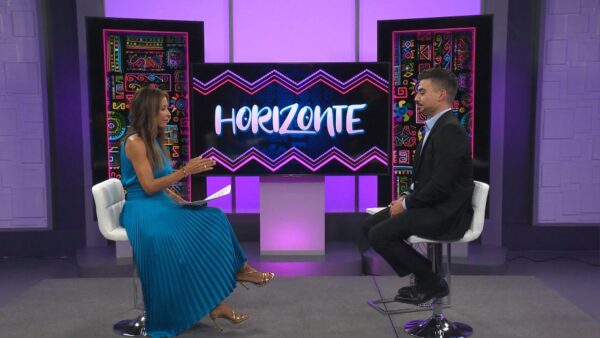In Sounds of Cultura (SOC), an exhibition celebrates Mexican American artwork and examines the identity of artists who have been influenced by the mixing of Mexican and American Culture in the United States. Michelle Nichols Dock, Gallery Coordinator for the Tempe Center for the Arts, talks about the exhibition.
José Cárdenas: In tonight's Sounds of Cultura, SOC, an exhibition examining works of Mexican-American art and the influence of the cultures of the United States and Mexico. With me to talk about the exhibition is Michelle Nichols dock, the gallery coordinator for the Tempe center for the arts.
José Cárdenas: Michelle, welcome to "Horizonte."
Michelle Nichols: Thank you for having me.
José Cárdenas: This is an interesting collaboration between your organization and the ASU Hispanic research center.
Michelle Nichols: It was. We were approached a couple of years ago with this idea. They were looking at pieces of their own collection and saw recurring themes and proposed the exhibition to us and we were all for it. And saw the possibilities of bringing in more collaboration into it as well.
José Cárdenas: Now, when we talked off camera, you mentioned this was something that neither you nor the Hispanic research center could have done on your own. Explain that.
Michelle Nichols: The exhibition features 42 artists and some are local and regional artists but some are actually nationally and internationally recognized artists like José Pasada and Norman Rockwell and Leopold and Louis Hermendez and we were able to pick and choose artwork from different collections because so many entities believed what they were doing and willing to loan us pieces and we had things from ASU art museum and things from Tucson museum of art and Chico of Chandler, local artists and Tempe history museum and local collectors. Either one of us couldn't have done it alone but bringing in all of these other entities and individuals we were able to bring together a magnificent and well rounded show with lots of things for people to see.
José Cárdenas: Now, José Pasada, a famous Mexican caricaturist in particular…
Michelle Nichols: Yeah.
José Cárdenas: …from near the turn of the last century, people would recognize that and understand why he or his work would be represented here. Norman Rockwell, nobody thought him as a Chicano…
Michelle Nichols: You didn't know that. [Laughter] We borrowed a Norman Rockwell 1942 era World War II poster featuring one of the four freedoms. The freedom from want - which is the famous Thanksgiving theme. We borrowed that from Tempe's history museum. Because of a piece from a Yuma artist, who as a piece that depicts a 1950s, kind of caricature of a kitchen which is from his memories of childhood and his aunt's Mexican kitchens and when we were talking to Larry, he's a humorous individual.
José Cárdenas: We've had him on the show.
Michelle Nichols: I can imagine. He said maybe he's a Chicano Rockwell for doing this kitchen scene. And we were kind of like - well, explain that a little more. Because we thought it was funny, but what was he inferring and he said he wasn't thinking about Norman Rockwell when he created the piece but after he created it and saw the Norman Rockwell, he saw the similarities. It's about family and it's about coming together and celebrating the things that you have in common and celebrating the American family, he was just doing it in a different way.
José Cárdenas: You had another piece -- this one by Frankie - we'll put on the screen in a moment -- that shows that same theme. This one is a fiesta type of event. You've got kids breaking the piñata and the hamburgers and hot dogs.
Michelle Nichols: Well he is Frank. He grew up in Phoenix and talking about in his text panels about being a American citizen and his parents pushing for he and his siblings to speak English and live the American dream but yet they were from a Mexican-American family and still celebrated ideas from their culture. In this piece, he has the dad figure has an apron that has a Mexican flag on it and in the background, there's children playing with a piñata. It's a combination of identities and influences from both American cultures and Mexican culture.
José Cárdenas: I should mention that was titled backyard party. And he had an interesting piece, slightly different imagery and different influences by Monica. We'll put that on the screen as well.
Michelle Nichols: ok.
José Cárdenas: Tell us about her work.
Michelle Nichols: Monica is a Phoenix artist and originally from El Paso, Texas, and went to New Mexico state university and talked about when she was in New Mexico being instructed by --
José Cárdenas: A close-up image of one of the images in the bigger picture.
Michelle Nichols: Right, and in the piece you don't right away see that.
José Cárdenas: What is that?
Michelle Nichols: For people that don't know, Milagros is like a charm. Sometimes made out of tin, sometimes out of precious metal. In parts of Mexico and the southern regions of the United States, people will pick out an arm, or heart, or something that represents something they want to be healed or praying for and you'll go into Church or a place in Mexico and you will see an altar piece covered with them and they represent little miracles.
José Cárdenas: And in that image we also saw the obvious influence to European work and obvious reference to DaVinci.
Michelle Nichols: Yes, she was reading human anatomy books because she's a drawing teacher and trying to update her skills and feature a lot of people in her work. Looking at that and when she was looking at the man, she saw similarities and influences she wanted to incorporate and she does a crucifix-like piece and has references to the man with the circle and square behind it.
José Cárdenas: We're almost out of time. Tell us about the educational component for the exhibition.
Michelle Nichols: The Tempe Center for the Arts is interested in community outreach and we do that through free admission and also free online curriculum for elementary and students and parents.
José Cárdenas: People can go to the website.
Michelle Nichols: They can see past ones we've done and here coming up, we'll have the mixing it up one
posted.
José Cárdenas: On that note, we'll end our show. Thank you for joining us.
Michelle Nichols: Thank you so much.
José Cárdenas: That's it for us tonight. From all of us here at "Horizonte," I'm José Cárdenas. Have a good evening.
Michelle Nichols Dock:Gallery Coordinator for the Tempe Center for the Arts;




















